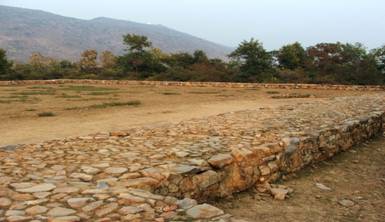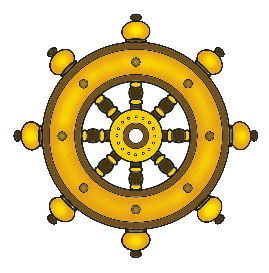
King Bimbisāra, born in 558 B.C.E., (2020 + 558 = 2,578 years), died in 491 B.C.E., (2020 + 491 = 2,511 years), and Enjoyed life 67 years old.
His father was king Bhattiya. Bimbisara was the King of Magadha and patron of the Buddha. He ascended the throne at the age of fifteen and reigned in Rājagaha for fifty two years.
https://www.youtube.com/user/Hoatraituhoc/videos
You are cordially invited to watch the Vietnamese and English Bilingual Lectures.
The Buddha was five years older than Bimbisāra, and less than fifteen years after ascending the throne, King Bimbisāra just listened to the Buddha’s sermon and became a lay disciple of the Buddha.
It is said (Mhv.ii.25ff.; Dpv.iii.50ff ) that the two were friends in their youth owing to the friendship which existed between their fathers. Bimbisāra’s father was called Bhāti (MT.137; Dpv.iii.52); according to Tibetan sources (Rockhill, op. cit., 16) his father was called Mahāpaduma and his Mother Bimbī.
But according to the Pabbajā Sutta (SN.vs.405ff.; also J.i.66 and DhA.i.85; also Rockhill, p. 27), the first meeting between the Buddha and king Bimbisāra took place in Rājagaha in the Pandavapabbata, only after the Buddha’s Renunciation.
When the king saw Siddhartha Gautama, an ascetic, young, tall, handsome, and deliberate monk pass below the windows of the palace, the king dispatched messengers to watch and knew the young monk was stopping by for lunch.

King Bimbisāra visited and invited Siddhartha Gautama to stay at the court and make an important position in the palace. However, the king’s invitation was not accepted by the young monk who said that he was prince Siddartha Gautama of Kapilavastu City giving up the throne to become a homeless monk.
Upon hearing this clearly, the king wished the young monk to attain enlightenment soon and remember to return to visit Rājagaha first right after his enlightenment.
To fulfill his good promise, as soon as he got enlightenment, the Buddha visited and prached the Dharma to King Bimbisāra and everyone in the palace. After listening to the Dharma, the king and all Dharma listeners attained the first saintly stage sotāpannas.

The following day, the king invited the Buddha and his Sangha to the palace to have mindfulness lunch. At that time, a group of choirs sang to praise the glory of the Buddha’s enlightenment.
Triratna Song
I love Buddha
I love Buddha
Yes, I do/ Yes, I do.
Buddha is my Teacher
Buddha is my Teacher.
Teaching me to be free
Teaching me to be free.
I love Dharma
I love Dharma
Yes, I do/ Yes, I do.
Dharma is my Sister
Dharma is my Sister.
Teaching me to be free
Teaching me to be free.
I love Sangha
I love Sangha
Yes, I do/ Yes, I do.
Sangha is my Brother
Sangha is my Brother.
Teaching me to be free
Teaching me to be free.
When the lunch ended, king Bimbisāra poured water from a golden vase in the Buddha’s hands and expressed the respectful heart to make offerings Veluvana monaster for the optional use of the Buddha and his Sangha. (Vin.i.35ff).
The Veluvana monastery built by King Bimbisāra was a noble gift to make offerings to the Buddha and his Sangha with five wishes of the king’s good achievements as follows:
1/ Bimbisāra became the king in Rājagaha
2/ The Buddha visited Rājagaha, where the king was reigned
3/ The king waited for the Buddha’s visit
4/ The Buddha preached the Dharma to the king and everyone in the palace.
5/ The kind and everyone in the palace understood the Dharma and attained the first saintly stage Sotāpanna (Vin.i.36) after listening to the Buddha’s teachings.
The king and everyone in the palace became lay disciples of the Buddha.
After attaining the first stage of sainthood Sotapanna, from now on till the rest of his life, for about 37 years, king Bimbisāra did his best to help Buddhism, the path of awakening and peace, develop rapidly in Indian society at that time. The king made his own vows to practice the six days of the pure precepts (uposatha) of every month (PvA.209).
According to polygamous regime, king Bimbisāra had a total of six wives:
- Chief Queen Kosaladevī, the sister of King Pasenadi of Kosala, has a prince named Ajātasattu (also J.iii.121).
- The second wife named Khemā
- The third wife Padumavatī, courtesan, has a prince named Abhaya
- The fourth wife Ambapālī has a prince named Vimala Kondañña
5.The fifth wife Sīlava, and
- The sixth wife Jayasena.
The second, third, and fourth wives later became Buddhist nuns, monastic disciples of the Buddha.
According to the commentaries, the death of Bimbisāra was a sad one (eg DA.i.135 ff; see also Vin.ii.190f).
Prophets had predicted that, before being born, Ajātasattu would bring about the death of his father, for that reason his mother wanted an abortion. But out of love for his son, King Bimbisāra did not do this, and when Ajātasattu was born, his father treated him with the greatest love.
When Ajatasattu was born, he frequently associated with his evil friend Devadatta, who persuaded Ajatasattu to delete the throne of king Bimbisāra by killing the king, the powerful patron for the Buddha and the Sangha.
Devadatta thought that Bimbisāra’s patronage of the Buddha was the greatest obstacle for Devadatta in his path of wanting to be a leader of the Sangha.
The dark plot of Ajātasattu and Devadatta has been uncovered. The courtiers of King Bimbisāra advised the king to kill Ajatasattu and forbid Ajātasattu from association with Devadatta. Because Ajatasattu was the son of king Bimbisāra, the king did not afford to kill and only advised his son not to interact with Devadatta.
But because of evil karma, because he wanted to usurp the throne, Ajātasattu still continued to communicate with Devadatta, who constantly encouraged and incited Ajātasattu to directly kill King Bimbisāra so that the king could no longer help and support the Buddha and the Sangha.
Because of greed for taking the throne of the king and following Devadatta’s evil words, waiting for when his father was sleeping, Ajātasattu ordered the flattery to arrest and starve his father into the dungeon, not allowing anyone to visit the king, except for his mother. Ajātasattu.
Every time she visited the king, Mrs. Vaidehi, the chief queen – wife of King Bimbisara, brought a golden vase filled with food, hidden in her clothes. Realizing this, Ajatasattu did not allow her to bring food when she visited the king.
Another time to visit the king, she bathed cleanly and smeared honey on her body for the king to use. This was the only source of food to help the king maintain his life.
In the end, the queen’s visits were forbidden; but the king still continued to maintain his life due to reciting the gratitude to the Triple gem and meditation pratice in the dungeon.

Upon hearing this, Ajātasattu sent babers into the prison to share the king’s open heels and cover the wound with salt and vinegar, and burn them with charcoal. When seeing them entering, King Bimbisāra thought that Ajātasattu, his son, asked the barbers to shave his beard and hair.
But the truth did not happen as King Bimbisāra thought. The barbers followed Ajātasattu’s orders.
The next day, knowing that he was about to die, practicing the Buddha’s teachings, King Bimbisara contemplated his body, mind, and karma:
“This body is not mine,
I am not limited by this body.
I am an infinite life,
I have never been born,
and also have never died.
Look! Sea is wide and sky is high,
densely innumerable stars.
All are together manifested in me
from the spiritual source of consciousness mind,
from all lives I am free.
Birth and death are the gateway in and out,
they are the hide-and-seek games.
Smile together with me.
Breathe together with me.
Practice meditation together with me
Recite the Buddhas’names together with me.”[1]
After finishing contemplating, the king died and let go of this physical body gently, and was reborn in the Cātummahārājika heaven as a deva continued to protect the Triple Gem.

Then a son of Ajātasattu was born immediately upon the death of King Bimbisāra. The joy experienced when his son was born made him realize something about the love his father had for him, and he questioned his mother.
Queen Vaidehi told him, her son, about stories of his childhood, and he repented, but too late, of his evil karma.
Soon after, his mother passed away because of the grief of her son’s evil karma. With Ajātasattu’s act of repentance, following the example of the Threefold Gem protection of his father king Bimbisāra, Ajātasattu continued to patronize Buddhism, especially during the first collection of Sutras in the Magadha kingdom.
When he was still alive, King Bimbisāra invited the Buddha to regularly gather and teach the Sangha on the first, the eighth, the fourteenth and the fifteenth days of each month. The request of the king was happily accepted by the Buddha. (Vin.i.101f.)
King Bimbisāra’s revered love for the Buddha was limitless. Upon hearing the Buddha visit Vesāli, the king had people repaired the entire path from Rājagaha to the Ganges and from the Ganges to Rājagaha, and decorated many different flowers on both sides of the road, each road, with a rest house for the Buddha and the Sangha to rest.
Two parasols were covered for Buddha and one for each monk. The king personally accompanied, protected and escorted the trip to take care of the Buddha, offering him flowers, perfumes, and all requisites for the Buddha and the Sangha during the journey lasting about over ten days. (DhA.iii.438 ff)

Relationships between King Bimbisāra and other kings in the vicinity and elsewhere
First of all, the friendly relationships between King Bimbisāra and King Pasenadi were very close.
They were connected by matrimony, each married a sister of the other living not only friendly with the kings in the neighboring region, but also with the kings in the other regions (Dvy.545) because they skillfully practiced and applied the five Buddhist ethical trainings into the daily royal life.
In Conclusion
King Bimbisāra and the Buddha, who were two great friends, had very intimate connections. One side was a political leader with secular life and happiness while the other side was a spiritual Master with life and happiness escaping from mundanity.
Once when king Bimbisāra and the Buddha met and greeted each other, the king said he was the happiest person in the royal palace while the Buddha said he was the happiest person in the world and far happier than the king. (M.i.95)
The Buddha said he had given up the path of being a king for a long time, because the path of being a king was busy so many secular things, mixed with much dispute, envy, jealousy, doubt, win, and losing in life while the path of being the Buddha let go of all that freely and calmly right here in this world. Upon hearing that, the king noted and understood the Buddha’s profound teachings, and made vows to support Buddhism wholeheartedly strongly.
Reference to Websites:
http://www.palikanon.com/english/pali_names/b/bimbisara.htm
https://vi.wikipedia.org/wiki/T%E1%BA%A7n-b%C3%A0-sa-la
http://www.buddhanet.net/e-learning/buddhism/lifebuddha/2_3lbud.htm
[1] See Anattalakkhana Sutta / http://www.youtube.com/watch?v=PdeVCWo5Bis






















